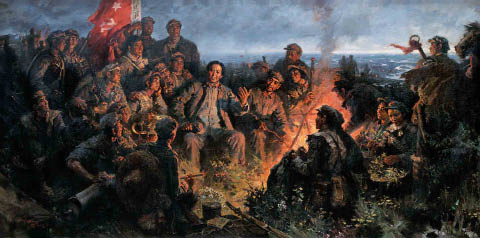| Shen Yaoyi’s Long March Classic Fetches US $6.4 Million
IT is not unusual for old masters’ paintings to fetch RMB10 million or more at auction these days. The same is fast becoming true of contemporary Chinese artworks. Bidding for Shen Yaoyi’s Revolutionary Ideals Higher than Heaven at the China Guardian 2012 auction of Chinese oil paintings and sculptures started at RMB 8.5 million. The masterpiece finally sold for RMB 40.25 million (about US $6.4 million) – the highest-ever price for any of his works.
Shen Yaoyi was born in Shanghai in 1943 and graduated from the Engraving Department of the Central Academy of Fine Arts in 1966. Having taught at Tianjin Academy of Fine Arts, the National Academy of Chinese Theater Arts and Renmin University’s Xu Beihong School of Arts, Shen is now a board member of the Chinese Artists Association and vice chairman of the Beijing Artists Association.
Shen was in his 30s in 1975 when he started work on the 185 cm by 375 cm oil painting Revolutionary Ideals Higher than Heaven, which he finished in 1976. The world famous Long March -- the Chinese Red Army’s 8,000-mile military retreat which took from 1934 to 1935 -- was the main theme of his artworks. Shen spent three months retracing the Long March route from Jiangxi Province in southeast China to Shaanxi Province in northwest China. Upon his return he created the graphic novel Following Chairman Mao on the Long March and started work on the oil paintings Revolutionary Ideals Higher than Heaven and Start of the Long March (part of the National Art Museum of China collection).
 |
| Revolutionary Ideals Higher than Heaven. |
The romantic effect of Shen’s realist technique and use of contrasting light and shadow singles out Revolutionary Ideals Higher than Heaven as a masterpiece. The oil painting shows Mao Zedong giving a rousing speech that obviously heartens his follow soldiers and acts as a beacon of warmth amid the arduous toil of their journey to safety in the same way as the blazing bonfire around which they gather to rest and listen. The painting pays tribute to Mao and the heroes that marched with him, giving broad scope to the shade of red that epitomizes their spirit. The figures in the picture appear robust and in ruddy health, and although set in darkness, the bonfire gives the scene a rosy glow. Shen Yaoyi thus vividly portrays the Long March scenario and the emotion it inspired in him personally as an artist.
“My first journey along the Long March route in 1975 was not enough to appreciate its full ethos. I had to take the trip several times before I could begin to comprehend the true feelings and experiences of those who had gone before me,” Shen said. He has traveled the Long March route a total five times and created similarly themed artworks such as The Red Ribbon of the Earth and Zunyi Conference (part of the National Museum of China collection), the former of which won the gold award at the Seventh National Fine Arts Exhibition and first prize in the Fourth National Illustrated Story Book Competition.
It took Shen Yaoyi six years from 1988 to 1993 to complete The Red Ribbon of the Earth series, which comprises five volumes and 926 pictures.
The size of the illustrations in the series differs. The first 163 pictures are 58 cm by 60 cm and the rest are 39 cm by 60 cm. To imbue the figures he portrays in these graphic artworks with their essential characters, Shen met and talked with veteran Long Marchers. Of the 100 people the illustrations depict, 77 are real. They include Chinese leaders Mao Zedong, Zhou Enlai, Zhu De, Wang Jiaxiang, Zhang Wentian and Peng Dehuai. Shen skillfully sets them against historical backdrops of battlefields, raging rivers, craggy mountains and treacherous swamps, all of which the Red Army faced along their arduous journey. In 2006, The Red Ribbon of the Earth broke auction records for illustrated storybooks when it fetched a price of RMB 15.4 million.
Artworks on China’s revolution are gaining in popularity because they embody both the ideology and passion of people of that time and represent the concepts of socialist realism and idealized visual art. Such artworks are crucial to the collective memory of several generations. Li Yanfeng, Oil Painting section manager of China Guardian, believes that the connotation of these pictures and the values they represent surpass their artistic influence. “The profound historical background reflected in these artworks draws both art lovers and art collectors to the market,” Li said.
| 